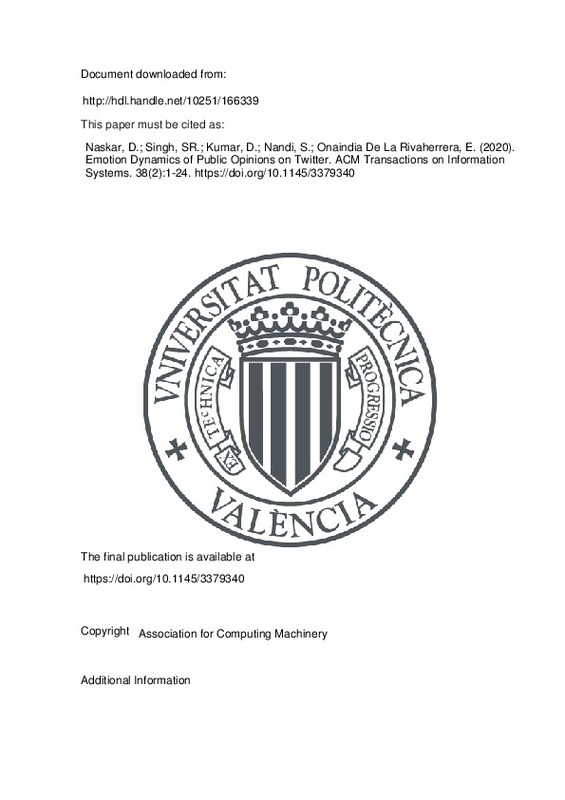Ahmed, S., Jaidka, K., & Cho, J. (2016). Tweeting India’s Nirbhaya protest: a study of emotional dynamics in an online social movement. Social Movement Studies, 16(4), 447-465. doi:10.1080/14742837.2016.1192457
Andrieu, C., de Freitas, N., Doucet, A., & Jordan, M. I. (2003). Machine Learning, 50(1/2), 5-43. doi:10.1023/a:1020281327116
Araujo, T., Neijens, P., & Vliegenthart, R. (2016). Getting the word out on Twitter: the role of influentials, information brokers and strong ties in building word-of-mouth for brands. International Journal of Advertising, 36(3), 496-513. doi:10.1080/02650487.2016.1173765
[+]
Ahmed, S., Jaidka, K., & Cho, J. (2016). Tweeting India’s Nirbhaya protest: a study of emotional dynamics in an online social movement. Social Movement Studies, 16(4), 447-465. doi:10.1080/14742837.2016.1192457
Andrieu, C., de Freitas, N., Doucet, A., & Jordan, M. I. (2003). Machine Learning, 50(1/2), 5-43. doi:10.1023/a:1020281327116
Araujo, T., Neijens, P., & Vliegenthart, R. (2016). Getting the word out on Twitter: the role of influentials, information brokers and strong ties in building word-of-mouth for brands. International Journal of Advertising, 36(3), 496-513. doi:10.1080/02650487.2016.1173765
Berger, J. (2011). Arousal Increases Social Transmission of Information. Psychological Science, 22(7), 891-893. doi:10.1177/0956797611413294
Bi, B., Tian, Y., Sismanis, Y., Balmin, A., & Cho, J. (2014). Scalable topic-specific influence analysis on microblogs. Proceedings of the 7th ACM international conference on Web search and data mining. doi:10.1145/2556195.2556229
Bollen, J., Mao, H., & Zeng, X. (2011). Twitter mood predicts the stock market. Journal of Computational Science, 2(1), 1-8. doi:10.1016/j.jocs.2010.12.007
Chen, W., Wang, C., & Wang, Y. (2010). Scalable influence maximization for prevalent viral marketing in large-scale social networks. Proceedings of the 16th ACM SIGKDD international conference on Knowledge discovery and data mining - KDD ’10. doi:10.1145/1835804.1835934
Ding, Z., Jia, Y., Zhou, B., Zhang, J., Han, Y., & Yu, C. (2013). An Influence Strength Measurement via Time-Aware Probabilistic Generative Model for Microblogs. Lecture Notes in Computer Science, 372-383. doi:10.1007/978-3-642-37401-2_38
Ding, Z., Wang, H., Guo, L., Qiao, F., Cao, J., & Shen, D. (2015). Finding Influential Users and Popular Contents on Twitter. Web Information Systems Engineering – WISE 2015, 267-275. doi:10.1007/978-3-319-26187-4_23
Feldman Barrett, L., & Russell, J. A. (1998). Independence and bipolarity in the structure of current affect. Journal of Personality and Social Psychology, 74(4), 967-984. doi:10.1037/0022-3514.74.4.967
Ferrara, E., & Yang, Z. (2015). Measuring Emotional Contagion in Social Media. PLOS ONE, 10(11), e0142390. doi:10.1371/journal.pone.0142390
Hillmann, R., & Trier, M. (2012). Dissemination Patterns and Associated Network Effects of Sentiments in Social Networks. 2012 IEEE/ACM International Conference on Advances in Social Networks Analysis and Mining. doi:10.1109/asonam.2012.88
Kwak, H., Lee, C., Park, H., & Moon, S. (2010). What is Twitter, a social network or a news media? Proceedings of the 19th international conference on World wide web - WWW ’10. doi:10.1145/1772690.1772751
Myers, S. A., Zhu, C., & Leskovec, J. (2012). Information diffusion and external influence in networks. Proceedings of the 18th ACM SIGKDD international conference on Knowledge discovery and data mining - KDD ’12. doi:10.1145/2339530.2339540
Nguyen, H. T., Ghosh, P., Mayo, M. L., & Dinh, T. N. (2017). Social Influence Spectrum at Scale. ACM Transactions on Information Systems, 36(2), 1-26. doi:10.1145/3086700
Pal, A., & Counts, S. (2011). Identifying topical authorities in microblogs. Proceedings of the fourth ACM international conference on Web search and data mining - WSDM ’11. doi:10.1145/1935826.1935843
Peng, S., Wang, G., & Xie, D. (2017). Social Influence Analysis in Social Networking Big Data: Opportunities and Challenges. IEEE Network, 31(1), 11-17. doi:10.1109/mnet.2016.1500104nm
Russell, J. A. (1980). A circumplex model of affect. Journal of Personality and Social Psychology, 39(6), 1161-1178. doi:10.1037/h0077714
Shi, J., Hu, P., Lai, K. K., & Chen, G. (2018). Determinants of users’ information dissemination behavior on social networking sites. Internet Research, 28(2), 393-418. doi:10.1108/intr-01-2017-0038
Silva, A., Guimarães, S., Meira, W., & Zaki, M. (2013). ProfileRank. Proceedings of the 7th Workshop on Social Network Mining and Analysis - SNAKDD ’13. doi:10.1145/2501025.2501033
Stieglitz, S., & Dang-Xuan, L. (2013). Emotions and Information Diffusion in Social Media—Sentiment of Microblogs and Sharing Behavior. Journal of Management Information Systems, 29(4), 217-248. doi:10.2753/mis0742-1222290408
Vardasbi, A., Faili, H., & Asadpour, M. (2017). SWIM. ACM Transactions on Information Systems, 36(1), 1-33. doi:10.1145/3072652
Wang, Y., Li, Y., Fan, J., & Tan, K.-L. (2018). Location-aware Influence Maximization over Dynamic Social Streams. ACM Transactions on Information Systems, 36(4), 1-35. doi:10.1145/3230871
Watts, D. J., & Dodds, P. S. (2007). Influentials, Networks, and Public Opinion Formation. Journal of Consumer Research, 34(4), 441-458. doi:10.1086/518527
Weng, J., Lim, E.-P., Jiang, J., & He, Q. (2010). TwitterRank. Proceedings of the third ACM international conference on Web search and data mining - WSDM ’10. doi:10.1145/1718487.1718520
Wolfsfeld, G., Segev, E., & Sheafer, T. (2013). Social Media and the Arab Spring. The International Journal of Press/Politics, 18(2), 115-137. doi:10.1177/1940161212471716
Yik, M. S. M., Russell, J. A., & Barrett, L. F. (1999). Structure of self-reported current affect: Integration and beyond. Journal of Personality and Social Psychology, 77(3), 600-619. doi:10.1037/0022-3514.77.3.600
Zhang, J., Zhang, R., Sun, J., Zhang, Y., & Zhang, C. (2016). TrueTop: A Sybil-Resilient System for User Influence Measurement on Twitter. IEEE/ACM Transactions on Networking, 24(5), 2834-2846. doi:10.1109/tnet.2015.2494059
Zhang, Y., Moe, W. W., & Schweidel, D. A. (2017). Modeling the role of message content and influencers in social media rebroadcasting. International Journal of Research in Marketing, 34(1), 100-119. doi:10.1016/j.ijresmar.2016.07.003
Ziegler, C.-N., & Lausen, G. (2005). Propagation Models for Trust and Distrust in Social Networks. Information Systems Frontiers, 7(4-5), 337-358. doi:10.1007/s10796-005-4807-3
[-]







![[Cerrado]](/themes/UPV/images/candado.png)


